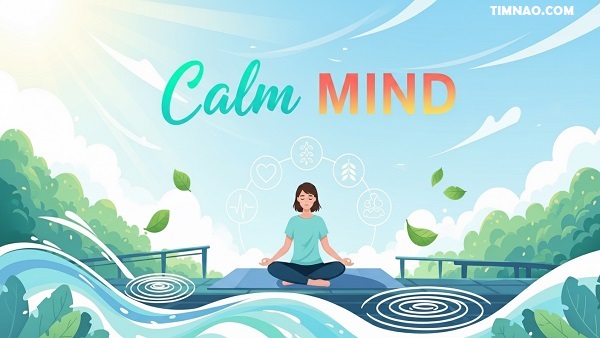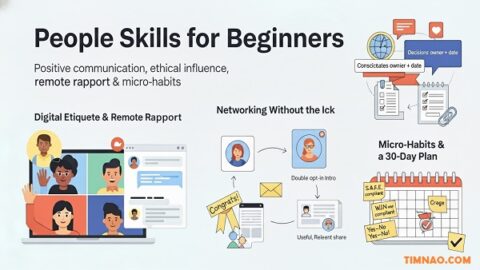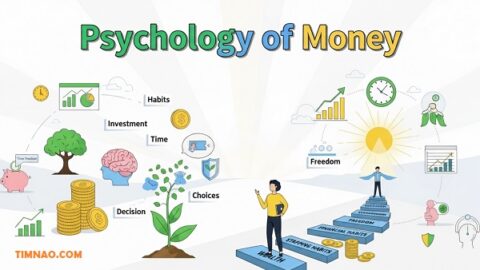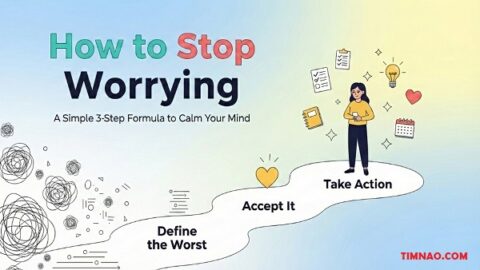Calm Mind Breakthrough: Take Back Your Peace in a Noisy World 🚀
Calm mind, anxiety management, and mindfulness for beginners don’t have to feel mysterious or out of reach. If your days are crowded with notifications, tense news cycles, and a brain that spins through “what ifs,” this guide is your friendly reset. You’ll learn simple, science-supported habits you can start today—and a 14-day plan to make them stick—so your mind is steadily calmer even when life is loud.
Table of Contents
- 🧭 Why Calm Beats Chaos (and What “Calm Mind” Really Means)
- 🌱 Lay the Groundwork: Clarity, Values & Tiny Wins
- 🧠 Think Better, Not More: Gentle Mental Skills for Beginners
- 💬 Feel It to Heal It: Express Emotions without Exploding
- 🫁 Body First Aid: Breath, Vagus Nerve & Movement Toolkit
- 🌙 Sleep Is Your Secret Weapon: Build a Calm-First Night Routine
- 📱 Mindful Inputs: Social Media, News & Music Without the Spiral
- 🗣️ Communicate to Regulate: Tone, Response, Praise, Apology
- ⚙️ Your “Calm System”: Routines, Environment & Helpful Apps
- 🗓️ The 14-Day Calm Starter Plan: Small Steps, Real Gains
- ❓ Frequently Asked Questions for Beginners
- ✅ Key Lessons & Takeaways
🧭 Why Calm Beats Chaos (and What “Calm Mind” Really Means)
In an era when our phones buzz every few seconds, headlines scream about disasters, and the pace of life seems to outstrip our ability to breathe, “calm” feels almost mythical. Yet cultivating a calm mind isn’t about escaping the noise—it’s about building inner steadiness so the noise doesn’t shake you.
A calm mind doesn’t mean suppressing emotion or being unbothered by everything. It means learning to return to balance when stress hits. Imagine your mind as a lake: the surface ripples when a stone falls in, but calm returns because the lake is deep and stable. You’re training that depth.
For beginners, the first step is noticing how often external chaos becomes internal chaos. You can’t always control the traffic, the email flood, or the news cycle—but you can decide how deeply it gets inside you. That decision begins with awareness.
The real cost of chaos
When life feels like a storm, your body joins in. Stress hormones spike, focus drops, and sleep disappears. Over time, this mental “background noise” becomes the default. The consequence? Even small problems start to feel enormous.
But calm isn’t just about surviving—it’s about thinking clearly enough to choose better. In neuroscience terms, calm strengthens the prefrontal cortex (your decision-making center) and quiets the amygdala (your alarm bell). That’s why calm people aren’t cold—they’re in command.
What “calm mind” really means
A calm mind is not an empty mind. You still think, feel, and act—but with space between the stimulus and your response. It’s the ability to notice a stressful thought like “I’m failing” and answer it with curiosity instead of panic.
This skill grows with practice, just like fitness. Each time you pause before reacting, you train your emotional muscles. The goal isn’t perfection; it’s recovery—shortening the distance between stress and stability.
A quick practice: the 10-second reset
Whenever you feel your thoughts racing, try this:
- Inhale through your nose for 4 counts.
- Exhale slowly for 8 counts.
- Repeat twice, feeling your shoulders drop each time.
It sounds small, but slowing the exhale activates the body’s relaxation system almost immediately. Do it before meetings, during arguments, or anytime you feel hijacked by emotion.
🌱 Lay the Groundwork: Clarity, Values & Tiny Wins
The journey to a calm mind begins long before meditation or deep breathing. It starts with clarity—knowing what truly matters to you. Chaos thrives in confusion. The clearer you are about your priorities, the quieter your mind becomes.
Step 1: Define your “why”
Ask yourself: Why do I want a calm mind?
Is it to sleep better, to stop snapping at loved ones, or to regain creativity? Your “why” turns vague motivation into direction. Write it in one sentence and keep it visible. On rough days, reread it—it’s your compass.
When you have a purpose, even ordinary days gain meaning. You stop chasing distractions because you’re anchored to something that matters.
Step 2: Know your core values
Values are your mental guardrails. Without them, decisions drain energy because you debate every little choice. When you know your values, life simplifies.
Here’s a simple reflection exercise:
- Think of a recent time you felt uneasy about a decision, even though it looked logical.
- Ask: what part of it felt off? Maybe it clashed with honesty, freedom, or kindness.
- That feeling points to one of your core values.
Most people discover 3–5 recurring themes that define them—perhaps integrity, growth, family, creativity, or freedom. Write them down. Next time you face a tough call, check if it aligns with your list.
Pro tip: When overwhelmed, values help you say “no” faster—and every “no” is a “yes” to calm.
Step 3: Align your work and relationships
It’s not enough to know your values; you have to live them. Suppose you value creativity but work in a job that punishes innovation. Or you value connection but avoid vulnerability. That mismatch creates chronic tension—an invisible stressor.
Audit your daily life:
- Does your work align with at least one key value?
- Do your relationships respect your boundaries and needs?
- Are your habits leading you toward or away from the person you want to be?
Small realignments—like finding creative outlets after work or having an honest talk about expectations—can release immense mental pressure.
Step 4: Win with micro-habits
Most people fail at calmness because they try to overhaul their life in one go. Instead, think tiny wins. The brain loves consistency, not intensity.
Here’s how to start:
- After brushing your teeth, take two deep breaths before leaving the bathroom.
- Before opening your laptop, set a 2-minute timer and write your top task.
- End each day by jotting one line about something that went right.
These micro-habits take seconds but create powerful signals: “I can direct my attention.” Over time, those small victories accumulate into a strong, calm baseline.
Step 5: Accept trade-offs
Clarity sometimes costs comfort. Choosing what aligns with your values might mean saying no to quick wins, social approval, or easy money. But peace grows from integrity. As philosopher Friedrich Nietzsche wrote, “To become who you are, you must be willing to stand alone.”
Calm doesn’t mean everyone will like your choices—it means you can live with them.
🧠 Think Better, Not More: Gentle Mental Skills for Beginners
If clarity quiets your heart, thinking better organizes your mind. Most of us aren’t overworked; we’re overthought. We confuse rumination with reflection. The difference? Reflection leads to insight; rumination loops endlessly without progress.
Step 1: Notice your mental traffic
The average person has around 60,000 thoughts per day—and about 80% of them repeat. Imagine trying to drive through that traffic without lanes! To calm the mind, start by noticing what fills it.
When anxiety spikes, pause and ask:
- “What story is my brain telling right now?”
- “Is this thought a fact or just a fear?”
Write one repeating worry on paper and label it: “I’m noticing the thought that…”. That tiny phrase separates you from your thoughts, giving space to breathe.
Step 2: Apply gentle structure to thinking
You can’t stop thoughts, but you can shape them. Try this 3-step structure whenever your mind spins:
- Define the issue (What’s really bothering me?)
- Decide if it’s controllable (Can I do something or not?)
- Do or Drop (If yes, take one action. If no, let it go.)
This method mirrors cognitive-behavioral therapy principles, helping beginners translate chaos into clarity. The point isn’t to suppress emotion but to redirect attention toward what you can change.
Step 3: Schedule your worry
This sounds strange, but it works. Pick a 10-minute slot in the evening as your “worry window.” When an anxious thought shows up during the day, tell yourself: “I’ll think about this at 8 p.m.”
By the time 8 p.m. comes, most worries will have lost their urgency. You’re teaching your brain that not every thought deserves attention.
Step 4: Identify your triggers
Chaos in the mind often begins with chaos in routine. Track moments that make you tense: certain people, apps, times of day, or lack of sleep. Once you know your triggers, you can plan responses instead of reacting.
For example:
- If Twitter doomscrolling ruins your mood, set app timers or check once a day after breakfast.
- If you get snappy when hungry, keep a snack handy.
- If late-night TV keeps you wired, swap it for calming audio or a short read.
Awareness + pre-planning = fewer emotional ambushes.
Step 5: Practice “no-thought” breaks
Your brain is a muscle—it tires. Insert micro-pauses through the day where you do nothing mentally:
- Watch the steam rise from your coffee.
- Feel your feet as you walk.
- Focus on your breath without forcing it.
Start with 30 seconds. You’ll be surprised how these small silences refresh focus and mood. In meditation science, this is called “mindful rest.” You’re not escaping the world—you’re letting your mind reset between tasks.
Step 6: Reframe imperfection
Beginners often chase calm as if it’s a flawless performance. But imperfection is part of the practice. Messy thoughts, skipped routines, or anxious mornings don’t erase progress. They’re proof that your mind is human.
When frustration rises, use a gentle reframe:
“Even this is part of learning calm.”
That mindset shift turns slip-ups into data, not defeats.
Step 7: Build hope and optimism
Optimism isn’t denial—it’s endurance with perspective. Studies show optimistic people recover faster from stress because they interpret setbacks as temporary, not permanent.
Try this weekly:
- Write down one small problem and one potential positive outcome.
- Even if it feels forced, imagine the best realistic scenario.
The brain can’t tell imagination from experience—it begins to feel calmer simply by rehearsing hope.
You’ve now laid the psychological foundation of calm—understanding what it means, clarifying your “why,” aligning your life with your values, and learning to think more effectively. In the next section, we’ll shift from the mind to the body, exploring simple tools like breathwork, vagus-nerve activation, and mindful movement—the fastest physical routes back to peace.
💬 Feel It to Heal It: Express Emotions without Exploding
We live in a culture that glorifies control—“stay strong,” “don’t cry,” “move on.” Yet bottling up emotion doesn’t make us stronger; it makes us tense, reactive, and distant. Emotional calm isn’t achieved by silence, but by safe expression—letting feelings flow without harming ourselves or others.
Why Suppressing Emotions Hurts
When you bury feelings, they don’t disappear. They linger, often resurfacing as anxiety, fatigue, or anger at minor things. Neuroscientists have found that emotional suppression activates stress circuits in the brain. The longer you hold it in, the more your body stays in fight-or-flight mode.
Instead, the goal is to process emotion safely. You can express sadness without sinking into despair, or anger without hurting someone. The trick is creating a container strong enough to hold the feeling until it settles.
Healthy Outlets for Emotional Release
- Write it out.
Journaling is like emotional decluttering. Don’t worry about grammar—just write how you feel for five minutes. The act of naming emotion reduces its power. - Move your energy.
Emotions live in the body. A brisk walk, shaking out your hands, or stretching releases the physical charge of emotion. - Cry when you need to.
Tears contain stress hormones. Crying actually helps the body return to balance. - Talk to someone safe.
If possible, speak with a friend who listens without judgment—or a therapist. Talking aloud helps translate emotions into words, which organizes the mind. - Creative expression.
Paint, cook, knit, or sing. When you create, you turn raw emotion into beauty.
The Art of “Pause Before React”
When anger strikes, most people lash out or shut down. Neither helps. Instead:
- Notice your reaction rising (tight chest, clenched jaw).
- Pause. Take one deep breath.
- Ask: “What’s the real feeling here?” Often, beneath anger lies hurt or fear.
- Respond after your body calms.
This brief gap between feeling and action is emotional mastery—the core of a Calm Mind.
🫁 Body First Aid: Breath, Vagus Nerve & Movement Toolkit
Your body is your fastest way back to calm. Thoughts may race, but the body can send the brain a signal: “You’re safe now.” Three simple pillars—breath, movement, and vagus nerve activation—make this possible.
1. Breath: The Built-In Reset Button
When you’re agitated, your breath shortens. The quickest fix is to lengthen your exhale—because exhaling activates the parasympathetic (relaxation) system.
Try this “4–8” method:
- Inhale through your nose for 4 counts.
- Exhale slowly for 8 counts.
- Repeat 20–25 times.
This technique stabilizes heart rate, oxygen flow, and emotional rhythm. Think of it as your Calm Mind emergency brake—instant, portable, and free.
2. Stimulate the Vagus Nerve
The vagus nerve is your body’s calm switch. It connects the brain to the gut, heart, and lungs—controlling rest and recovery. You can activate it daily with simple techniques:
- Deep breathing. The slower you breathe, the more the vagus nerve engages.
- Cold exposure. Splash cold water on your face or take a short cool shower—it quickly resets the stress response.
- Humming or singing. Because the vagus runs through your throat, vocal vibration stimulates it naturally. Try humming with your mouth closed for 60 seconds.
- Laughter. Yes, genuine laughter vibrates the vagus too!
When practiced regularly, these cues teach your body how to return to baseline faster after stress.
3. Move Your Body, Move Your Mood
Motion changes emotion. Studies show even small movements—rolling your shoulders, stretching, walking—improve mood by shifting brain chemistry.
Start simple:
- Stand and stretch every 45 minutes.
- Do five squats after long sitting sessions.
- Smile intentionally—yes, smiling tricks the brain into releasing serotonin.
If you enjoy it, level up: dance, play sports, or take yoga. But even two minutes of deliberate movement counts. The secret? Consistency over intensity.
4. Create Your “Anchor Point”
Everyone needs a daily anchor—an activity that grounds you. It could be walking, journaling, painting, or gardening.
Choose something that engages both mind and body, and do it at roughly the same time daily. This rhythm teaches your nervous system that peace is predictable, not random.
“Move, breathe, repeat.” That’s your calm recipe.
🌙 Sleep Is Your Secret Weapon: Build a Calm-First Night Routine
You can’t have a calm mind in a tired body. Sleep isn’t a luxury—it’s your neural reset system. Without it, even small problems feel impossible.
Why Sleep Fuels Calm
Sleep clears the brain of toxins, resets stress hormones, and consolidates emotional memories. A lack of it makes you irritable and unfocused. In fact, one sleepless night can increase amygdala reactivity (your brain’s fear center) by up to 60%.
Build Your “Calm-First” Night Routine
- Set a bedtime anchor.
Go to bed and wake up at the same time daily—even on weekends. This trains your circadian rhythm like muscle memory. - Use the “wind-down alarm.”
Set an alarm 30 minutes before bedtime to stop scrolling and start relaxing. Treat it like a meeting with your Calm Mind. - Dim lights, cool room.
Lower lighting and temperature to signal your body that it’s time to rest. - Cut the blue light.
Avoid screens an hour before bed. Blue light tells your brain it’s still daytime. - Journal your worries.
Write tomorrow’s to-do list and one gratitude note. This empties mental clutter. - Try gentle movement.
Stretch, breathe, or listen to calming music. Yoga nidra or guided relaxation audios help too. - Rethink caffeine and alcohol.
Both disrupt REM sleep. Stick to coffee before noon and skip nightcaps.
When Sleep Feels Elusive
If you lie awake, don’t fight it. Try this:
- Breathe slowly and repeat the phrase “I’m safe and resting.”
- Visualize relaxing scenes instead of counting hours.
- If you’re awake for 20+ minutes, get up and do something calm in dim light, like reading.
Over time, your body learns that the bed equals rest, not rumination.
Advanced Tips for Deeper Rest
- Morning sunlight: Step outside early—natural light sets your biological clock.
- Exercise regularly: Even 20 minutes of walking boosts nighttime sleep quality.
- Nutrition: Avoid heavy meals before bed; choose light, balanced dinners.
A Realistic Expectation
You don’t need perfect sleep—you need consistent recovery. Some nights will be rough. That’s okay. The goal isn’t eight flawless hours—it’s teaching your body to slow down, even when life won’t.
“Sleep is not escape; it’s preparation. A calm morning begins the night before.”
Now that you’ve mastered emotional flow, body regulation, and restful sleep, your foundation for a Calm Mind is strong. In the next part, we’ll explore how to manage your inputs—from social media to music—so your environment supports, not sabotages, your calm.
📱 Mindful Inputs: Social Media, News & Music Without the Spiral
Modern life floods our senses with constant noise. Notifications, trending hashtags, viral videos, breaking news — it never ends. A calm mind can’t grow in chaos unless you learn how to control your inputs. Mindful consumption means choosing what enters your brain just as carefully as what you eat. You can’t expect mental stillness when your digital diet is all junk.
The Attention Economy and Why It Steals Your Peace
Social media platforms are engineered for addiction. According to Harvard Health Publishing, every swipe or “like” delivers a tiny dopamine rush, teaching your brain to seek more. Over time, you crave stimulation, not connection. That’s why you can spend hours scrolling yet feel drained afterward — it’s not rest; it’s overstimulation.
A calm mind needs fewer inputs, not more. You don’t need to disconnect from technology entirely; you just need to consume intentionally. Let’s explore how to make digital spaces work for you instead of against you.
Social Media: Curate Instead of Consume
Social media can inspire, educate, and connect — but only if you take charge of it. Here’s how to detox your feed without deleting your apps:
- Audit your follows. Unfollow accounts that trigger comparison or negativity. Follow creators who teach, uplift, or calm you. Examples include mindfulness pages like Calm, Headspace, or the Greater Good Science Center.
- Create viewing windows. Check your feeds twice daily, perhaps after breakfast and before dinner. Set time limits using Digital Wellbeing on Android or Screen Time for iOS.
- Mute notifications. You don’t need to know every comment instantly. Constant pings hijack attention and raise anxiety.
- Post consciously. Before you share, ask: “Is this adding noise or value?” Posting from calm, not chaos, changes your relationship with social media.
A simple mantra: Don’t let your feed decide your mood.
News: Stay Informed Without Losing Sanity
The news cycle today is endless, urgent, and often alarmist. Studies from the American Psychological Association show that excessive news exposure increases anxiety and sleep problems. Yet avoiding news completely can make you feel detached or unprepared. The solution? Mindful boundaries.
Try these habits:
- Limit your exposure. Ten minutes a day is enough to stay informed. Use balanced outlets like BBC News, Reuters, or Associated Press.
- Batch your updates. Read or watch once daily instead of grazing throughout the day.
- Balance the bad. For every grim headline, read one uplifting story. You can find them on Positive News.
- Turn off autoplay. Don’t let videos drag you deeper into negative spirals.
- Reframe statistics. If you read that something has a “20% chance of failure,” remember — it also means there’s an 80% chance of success.
Being informed is responsible. Being consumed is optional.
Music: Tune Your Mind, Don’t Distract It
Music can be a powerful emotional regulator. It’s not just entertainment; it’s therapy. Research from Cleveland Clinic shows that calming music lowers heart rate and cortisol levels, while upbeat rhythms elevate mood and motivation.
Practical ways to use music for calm:
- Create “energy playlists.” One for relaxing (slow acoustic, ambient), one for focusing (instrumental, lo-fi), and one for lifting energy (pop or funk).
- Use sound apps. Try Noisli for white noise, or Endel for adaptive soundscapes.
- Sing or hum. The vibration stimulates the vagus nerve — your body’s built-in stress regulator.
- Choose silence occasionally. If your environment is always noisy, your brain never rests. Schedule 10–15 minutes of silence daily.
When used consciously, music isn’t an escape — it’s a reset button.
🗣️ Communicate to Regulate: Tone, Response, Praise, Apology
Calm isn’t just an internal state; it’s a social language. The way you communicate determines whether interactions soothe or ignite stress. Mastering calm communication protects both relationships and your mental energy.
The Power of Tone
Tone transmits emotional data faster than words. A calm tone tells others, “We’re safe,” while a sharp one triggers defensiveness. According to Harvard Business Review, emotional tone predicts cooperation more than logic does.
Try this experiment:
Record your voice explaining a point twice — once while tense, once while relaxed. Play both versions. Notice how your energy shifts. A simple change in tone can turn confrontation into connection.
Practical tips:
- Slow down your speech by 10%.
- Drop your voice slightly instead of raising it.
- Smile softly while talking — people can hear the difference.
- If you feel anger rising, pause before replying.
Respond Instead of React
Your calm mind lives in the pause. Reaction is emotional autopilot; response is mindful choice.
When conflict hits:
- Inhale deeply and exhale longer.
- Ask yourself, “Am I reacting to the situation or my story about it?”
- If unsure, step away. Say, “Let me think this through.”
That moment of space stops emotional chain reactions. It doesn’t mean avoidance — it means self-leadership.
Praise Before Correction
Constructive feedback lands best when wrapped in appreciation. Human beings crave acknowledgment before advice.
Use the P.E.A. Formula:
- Praise: Start with something true and positive.
- Explain: Share your observation or request calmly.
- Appreciate: End with encouragement or gratitude.
Example:
“You’ve been so consistent with your work lately. Let’s refine this section together — it’ll elevate the whole piece.”
It feels collaborative instead of critical. Practice this daily with colleagues, partners, or children; you’ll notice calmer conversations and better outcomes.
The Courage to Apologize
Apologies release tension faster than arguments ever could. They’re not about surrendering pride but about restoring peace. According to the Greater Good Science Center, sincere apologies lower stress and improve relationships.
When apologizing:
- Be specific. “I’m sorry for interrupting earlier,” not “Sorry if you felt bad.”
- Remove the word but. (“I’m sorry, but…” cancels the apology.)
- Keep your tone soft and your eye contact steady.
Apologizing isn’t losing — it’s resetting emotional connection. The fastest way to calm in relationships is humility.
Words Are Energy
Words linger. They build atmospheres. Before you send that message or comment online, pause and ask:
“Will this create calm or chaos?”
You can’t control others’ reactions, but you can control your contribution. Words are invisible architecture — they shape every emotional room you enter.
⚙️ Your “Calm System”: Routines, Environment & Helpful Apps
Calm isn’t luck. It’s design. You build it through systems—daily rhythms, physical environments, and tools that make peace automatic. When your surroundings support serenity, willpower becomes unnecessary.
Routine: The Structure of Serenity
Structure creates psychological safety. You don’t have to plan every minute; you just need predictable anchors throughout the day.
Three calm anchors to begin with:
- Morning grounding: 5 minutes of breathing, sunlight exposure, and gratitude journaling (try Five Minute Journal).
- Midday reset: Step outside or stretch for 3 minutes between tasks.
- Evening shutdown: Turn off screens 60 minutes before sleep, sip herbal tea, and reflect on three wins of the day.
These anchors teach your body when to rise, work, and rest. Over time, your nervous system syncs with them automatically.
Design a Calm Space
Your environment speaks to your subconscious. Clutter tells your brain to stay alert; order whispers, “You’re safe.”
Actionable changes:
- Declutter visible surfaces.
- Introduce natural textures — wood, plants, or soft fabrics.
- Add a scent diffuser with lavender or sandalwood.
- Use soft, warm lighting instead of harsh LEDs.
If you work from home, separate “focus space” from “rest space.” Even a different chair or lighting cue helps your brain switch modes.
For gentle ambient sound, visit Rainy Mood or explore nature sounds on Calm.
Digital Boundaries
Your phone is your greatest tool and your biggest trigger. You must train it to serve you, not control you.
Practical digital declutter checklist:
- Silence unnecessary notifications.
- Move distracting apps (like Instagram or TikTok) off the home screen.
- Use Forest or Freedom to block distractions during focus time.
- Establish “no-phone zones” — the dinner table, bedroom, and first 30 minutes after waking.
Boundaries don’t limit your freedom—they protect it.
Helpful Apps for Calm and Focus
If used wisely, technology can nurture calm rather than destroy it.
- Calm: Guided meditations, breathing, and soothing sleep stories.
- Headspace: Mindfulness training and short guided breaks.
- Insight Timer: Thousands of free meditations and community groups.
- Todoist or Notion: For decluttering tasks and tracking habits.
- Sleep Cycle: Monitors your rest patterns for better recovery.
These aren’t escapes—they’re instruments for awareness. Use them to build consistency, not dependency.
Reflect and Adjust
No system stays perfect forever. Each week, take five minutes to ask yourself:
- What drained me this week?
- What restored me?
- What can I simplify next week?
That short reflection keeps your calm habits alive instead of automatic. Growth is maintenance — not magic.
🗓️ The 14-Day Calm Starter Plan: Small Steps, Real Gains
The Calm Mind isn’t built overnight—it’s trained, layer by layer, through small, realistic actions. This 14-day plan is your blueprint for that transformation. You don’t need hours of meditation or a lifestyle overhaul; you just need consistency and a willingness to experiment.
The plan focuses on three pillars: mind, body, and environment. Each day introduces a micro-action designed to reset your nervous system and strengthen emotional resilience.
Week 1: Reset the Noise
Day 1: The Calm Audit
Spend 20 minutes reflecting on your day-to-day chaos triggers. Write down:
- What situations spike your stress?
- Who drains or uplifts your energy?
- When do you feel most at ease?
Awareness is step one.
Day 2: Morning Breath Ritual
Before checking your phone, sit upright and take ten slow breaths. Inhale through your nose for 4 counts, exhale through your mouth for 8. Feel your body relax.
Day 3: 5-Minute Declutter
Choose one surface—your desk, bag, or nightstand. Clear it completely. Physical clutter is mental clutter in disguise.
Day 4: Social Media Reset
Unfollow or mute three accounts that trigger comparison or negativity. Then follow one account that brings peace or inspiration.
Day 5: Gratitude Snapshot
At night, jot down three things that went right today—no matter how small. Gratitude rewires the brain for optimism.
Day 6: The Power of “Pause”
Throughout the day, whenever tension rises, take a 5-second pause. Ask yourself: “What’s really happening here?” Calm starts in the pause, not the reaction.
Day 7: Digital Sunset
Stop all screens one hour before bed. Dim lights, stretch, and listen to soft music. Let your body remember how to slow down.
Week 2: Build Your Calm Muscles
Day 8: Movement Snack
Set a timer for every 90 minutes of sitting. When it goes off, stretch, walk, or shake your hands for one minute. Movement keeps anxiety from accumulating.
Day 9: Mindful Listening
In one conversation today, listen without interrupting or planning your reply. Let the other person finish fully. It’s harder than it sounds—but deeply calming.
Day 10: The Calm Corner
Create a small “calm zone” at home—a chair near a window, a scented candle, or a journal. Return to it whenever you feel overstimulated.
Day 11: Emotional Check-In
Pause three times today and ask: “What emotion am I feeling right now?” Naming emotion reduces its grip on you.
Day 12: 10-Minute Nature Reset
Step outside. No phone, no podcast—just observe. Nature stabilizes your nervous system faster than any app.
Day 13: Reframe One Thought
Catch one negative thought (“I’m behind,” “I can’t handle this”) and replace it with a realistic one: “I’m learning to manage things at my own pace.”
Day 14: Reflect & Celebrate
Revisit your notes. What improved? Which habits made you lighter? Write a short reflection—it seals your progress.
In just 14 days, you’ll notice shorter stress recovery times, clearer focus, and gentler self-talk. That’s the start of your Calm Mind muscle taking shape.
❓ Frequently Asked Questions for Beginners
1. What if I miss a day?
Don’t punish yourself—just pick up where you left off. Calm isn’t a race; it’s rhythm.
2. How much time do I need daily?
10–20 minutes is enough. The power lies in regularity, not duration.
3. I live in a chaotic household—how can I stay consistent?
Use “micro-moments” of calm. Even one deep breath before replying or 2 minutes of silence after waking counts.
4. I tried meditation but can’t focus. What should I do?
Meditation isn’t about emptying your mind; it’s about noticing. Try guided audios, mindful walking, or simply observing your breath.
5. How long until I feel results?
Some notice change in days; others in weeks. Think of calm as a skill—every repetition strengthens it.
6. Can I combine this with therapy or medication?
Absolutely. These tools complement professional help beautifully. Always consult your doctor before making adjustments.
7. What if my family or workplace keeps triggering me?
You can’t control others, only your reactions. Use grounding tools (breath, pause, walk) before engaging. Over time, you’ll respond from clarity, not chaos.
✅ Key Lessons & Takeaways
1. Calm Is a Practice, Not a Personality
No one is born calm; it’s trained through repetition—just like fitness.
2. Start Small, Stay Consistent
Tiny, repeatable actions—five deep breaths, one clean corner, a five-minute journal—build long-term serenity.
3. Awareness Beats Avoidance
Suppressing stress doesn’t erase it; awareness dissolves it. Notice your emotions before they snowball.
4. The Body Leads the Mind
Your body is the doorway to peace. Breathing, movement, and rest reset your brain faster than thinking harder.
5. Environment Shapes Emotion
Curate your surroundings—digital and physical. Calm thrives where clutter, noise, and chaos are reduced.
6. Progress Over Perfection
You’ll have bad days. The win isn’t never losing calm—it’s recovering faster each time.
7. Make Calm a Lifestyle
Embed it into your routines—how you eat, move, scroll, and speak. When calm becomes automatic, chaos loses control over you.
You don’t need to escape life to find peace—you need to build peace within the life you already have. A Calm Mind is not passive; it’s powerful. It lets you think clearly, act kindly, and live fully, even when the world is loud.
So take a breath. Begin today. The calm you’re seeking is already inside you—waiting to be practiced.
Disclaimer
This article is intended for informational and educational purposes only. The content shared here reflects general well-being practices and psychological insights designed to help readers cultivate a calmer, more mindful life. It should not be taken as medical, psychological, or professional advice.
While all suggestions and tools mentioned—such as mindfulness techniques, breathing exercises, and mobile apps—are supported by reputable sources, individual experiences may vary. Always consult with a qualified healthcare provider, therapist, or mental health professional before making significant lifestyle or treatment changes, especially if you are dealing with chronic stress, anxiety disorders, depression, or other mental health concerns.
Links to third-party websites or apps (e.g., Calm, Headspace, Forest, and Freedom) are provided for convenience only. The author and publisher are not responsible for the accuracy, content, or privacy policies of those external sites.
Use the practices in this guide as a supportive addition, not a substitute for professional care. If you ever feel overwhelmed, unsafe, or in crisis, please reach out to your local mental health helpline or emergency services for immediate support.






